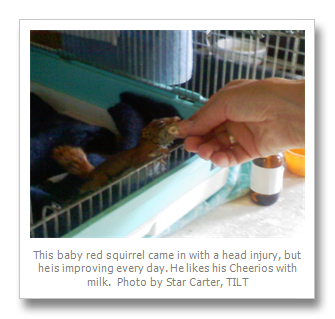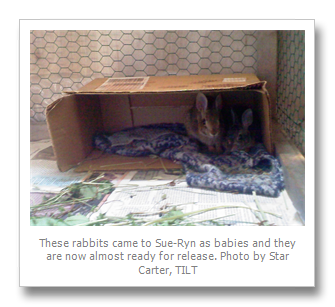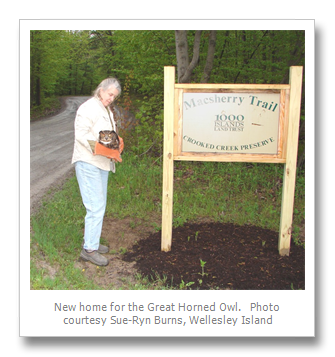A few weeks ago, Sue-Ryn Burns called the TILT office asking permission to release a Great Horned Owl at the Crooked Creek Preserve. The owl had been hit by car on Christmas Eve. Sue-Ryn took the owl to Jean Soprano, who transferred it to Cornell’s Animal Veterinary program. The students there put two pins in the owl’s leg. After the bones had set, the pins were removed and the owl went back to Jean’s for rehabilitation. Sue-Ryn picked him up and kept him until he was finally ready to go back to the wild. Sue-Ryn thought the preserve would make a lovely new home. She sent us a picture of the release and after five months in captivity and traveling across the state for rehab, the owl certainly looked ready to be free! It was a true, feel good moment that I shared with everyone I knew.
Sue-Ryn Burns
Sue-Ryn Burns has a presence that is at once calming and comforting. Her hands moved surely as she scooped a mixture of high protein cat food, seeds, dried insects, and vitamins onto a tiny paint brush and offered it to a demanding young bird. He took the food with less enthusiasm than I expected. Sue-Ryn chuckled and told me that this food mixture isn’t his favorite, but he’s outgrown the really tasty stuff.
Sue-Ryn is a licensed wildlife rehabilitator on Wellesley Island. She takes in sick, injured, orphaned, and displaced animals all year round and nurses them until they are ready to go back into the wild. Sue-Ryn received her state license in 2005 and her federal permit in 2009, which allows her to handle and keep federally protected migratory birds. She houses and rehabilitates animals in a little barn next to her home and in various sized enclosures around her yard. Sue-Ryn will take in small mammals like rabbits, squirrels, opossums, and field mice, and birds of all sizes and species.
When Sue-Ryn receives an animal, she first checks it over for major injuries. She prefers to make the animal comfortable in an enclosure and then leave it alone for 45 minutes to give it time to calm down and acclimate to the new surroundings. Sue-Ryn will then start the routine of feeding, nursing, and cleaning. This is the main job of a rehabilitator – put food in and then clean up the mess. Nestlings need to be fed every hour, so when the barn is full of young birds, Sue-Ryn may only get a half hour break between feedings. This is a full time job!

This day, Sue-Ryn had a variety of animals to care for. She showed me a box of five tiny woodpecker nestlings. They were given to her after a homeowner had trees cut on their property. They didn’t realize one of those trees was occupied by this woodpecker family. The tree crashed down and these little nestlings, now orphaned, were found scattered in the leaf litter. The homeowner called Sue-Ryn and she took the little birds into her care. She told me that when they arrived, they were even tinier and didn’t have any feathers. Now, they’ve grown in some feathers and two red streaks are visible on the top of a few of their heads. One of the woodpeckers started cheeping loudly. Sue-Ryn picked up a very small syringe filled with a yellowish brown mixture with the consistency of mustard, a nestling food formula, and filled the young bird’s crop with food. She offered the syringe to the rest of the woodpeckers and after a couple squirts in each little mouth, they quieted down, full and satisfied for now.

Neighboring boxes housed more nestlings all clamoring for food. Another container held the tiniest little field mouse. He was the lone survivor of nest of mice brought in to Sue-Ryn. She was also caring for a baby squirrel with a head injury. He was hiding in a “woolly”, a pocket made from felted wool, but he came out when Sue-Ryn opened the cage door, wobbly and a little disoriented. She offered him a Cheerio dipped in milk. Sue-Ryn was concerned that he may have a jaw injury because he had a difficult time eating, but the squirrel took a few nibbles of the Cheerio. He was on medication for pain and inflammation and Sue-Ryn commented that he seemed livelier and was improving each day. As if to prove the point, the little squirrel scampered up the side of the cage and hung there for a moment, before retreating back into the woolly for a nap.

Two rabbits were cuddled up in a box inside another enclosure on the floor. Each day, Sue-Ryn gives them several “bunny bouquets” of greens from her yard to munch on. These two were nearly ready for release. The criteria for release are pretty simple: injuries need to be healed, and the animal must be able to feed itself and be aware of its surroundings. Birds of prey, like hawks and owls, need to be able to perch. Some animals can never be released into the wild. These animals go to zoos and other wildlife education facilities. The New York State Zoo at Thompson Park in Watertown has a turkey vulture that Sue-Ryn rehabilitated but could not release.
Outside, Sue-Ryn took me into an aviary that had been donated to her. The sides of the aviary were covered with special netting that wouldn’t injure the birds if they flew into it. About 10 older starlings were fluttering around. A tray of cat food mixed with water, mealworms, and seeds sat untouched in the corner. Sue-Ryn pinched a bit of food in her fingers and offered it to the closest starling. He excitedly hopped over with his beak held wide open, straining forward, but stopped just millimeters from her fingers. He stood waiting for Sue-Ryn to pop the food in his mouth and she waited for him to take it. These birds might be flying, but they hadn’t yet learned to feed themselves. A few days, Sue-Ryn assured me, and they will be eating from the tray on their own. Without their parents around to teach them, it takes animals a little longer to learn these important skills.
There is no substitute for a parent and baby animals are always better off in the wild. How do you know if an animal needs rescuing? Sue-Ryn explained that often people find young birds on the ground and assume that they need help. Usually, these are fledglings and the parents are nearby, watching over the young birds and feeding them. Mother deer will hide their fawns and leave them alone, but the mother is close and will return to care for it. If you leave the area, these youngsters will be fine.
If you observe an animal that has been injured, you know the parent of a young animal is dead, or it has not been tended to by a parent for more than six hours, you should call a wildlife rehabilitator. If Sue-Ryn is unable to come out to capture the animal, she can talk you through the process. It is illegal to keep a wild animal for an extended period of time if you are not licensed, so you should take it to a facility as soon as possible.
Some animals have a better chance at rehab than others. Ospreys are a particular challenge. Ospreys are dangerous to handle, with their hooked beaks and sharp talons, and they are very difficult to feed. An Osprey is adapted to dive for its food and they almost exclusively eat fish. In rehabilitation, they don’t usually learn to self feed. Unfortunately, as the Osprey population is increasing on the River, so are the calls about injured Ospreys. They are very focused hunters; a diving Osprey might fly right into a boat accidentally. They are also nesting in some unusual areas along the river. Sue-Ryn stressed that people need to be more aware of these birds and try to avoid collisions.
We walked back into the barn to a fresh chorus of chirps and peeps. Sue-Ryn works hard to keep all of these animals safe, comfortable, and strong enough to go back to the wild. Not all of them survive. We talked about the losses and I asked her how she handles it. Sue-Ryn recited a poem by Rumi: “Oh, break my heart, Oh, break it again, So I can love even more.” She told me that she feels the loss of each and every animal and she doesn’t ever get used to the deaths. Sometimes, when an animal is in pain and fear, the death is a relief and she takes comfort in the fact that she helped the animal pass in a safe, warm, and comfortable place. Sue-Ryn buries most of the animals; a final gift of respect to the lost life. To some people, it might just be a mouse or a squirrel, but to Sue-Ryn, it is that mouse and that squirrel. She took responsibility for that beating heart. It is a life that matters, no matter how small or abundant the creature may be. The smallest animals are an important part of the food chain, providing food for the larger, more “beautiful” species that people enjoy, like foxes, owls and eagles. She feels sad for every lost animal, but there are always more in the barn that need feeding, cleaning, and care. Being busy is the best distraction.
Busy is an understatement. Sue-Ryn always has animals in the cages to look after. She told me that there is a need for more wildlife rehabilitators. If you are interested in becoming a rehabilitator, the best way to start is to volunteer with one. Cages need to be cleaned, food needs to be prepared, and supplies have to be gathered. To become licensed, you will need 200 hours of apprenticeship, the recommendation of a licensed wildlife rehabilitator, and a designated veterinarian who will work with you. The commitment of time, patience, and resources is enormous, but as Sue-Ryn demonstrates, the rewards are just as big. Sue-Ryn runs her rehabilitation facility entirely on donations and she holds garage sales to raise funds to cover the costs of food, supplies, caging, and fuel. You can see her “wish list” of items on her webpage: http://www.wellesleyisland.net/wellesleyislandwildlife.htm

I left Sue-Ryn’s place as she started another round of feeding, starting again with the noisy woodpeckers. The Thousand Islands are fortunate to have such a dedicated and talented resource for wildlife. I have called Sue-Ryn twice for injured wildlife since I started working at the Thousand Islands Land Trust (TILT). If she can’t take an animal, she refers people to Dr. David Plante at North County Animal Health Center, the only veterinarian in the area that will accept wildlife. She works closely with Jean Soprano and her group of rehabilitators at Kindred Kingdoms near Syracuse and will sometimes send animals to their larger facility if needed. Sue-Ryn releases animals on her family property, on private land with permission, and at State Parks and preserves.
Seeing Sue-Ryn standing beside the Macsherry Trail sign and knowing that the preserve would make an ideal habitat for the once injured Great Horned Owl, I knew this was special. Yes, we can all appreciate a fairy-tale happy ending every once in a while.
Many thanks to Sue-Ryn Burns and her husband Steve for all of their hard work, dedication, and deep compassion for wildlife. You can contact Sue-Ryn for an animal emergency at 315-482-2985, or 1-800-600-3831.
By Star Carter, Director of Land Conservation, Thousand Islands Land Trust. scarter@tilandtrust.org
Star Carter is the Director of Land Conservation for the Thousand Islands Land Trust. Originally from Hawaii, she is now a permanent resident of northern New York. Always drawn to water and wildlife, she feels lucky to be working on the beautiful St. Lawrence River. Star has a degree in Animal Science from the University of Hawaii, and is now completing a Masters program at Penn State. In 2009 Star worked for the Clayton Island Tours and contributed Summer Eco-Tours for TI Life in October 2009.
This summer Star has organized several new “TILTreks” for the Thousand Islands Land Trust, from archeological digs, to biking excursions and many trail hikes in between. Be sure to check the TILT website for the date of these next TILTrek adventures.